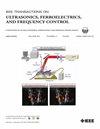猕猴颅部单探头折射校正经颅被动声学定位。
IF 3.7
2区 工程技术
Q1 ACOUSTICS
IEEE transactions on ultrasonics, ferroelectrics, and frequency control
Pub Date : 2025-03-19
DOI:10.1109/TUFFC.2025.3570971
引用次数: 0
摘要
在微泡(MB)空化介导的血脑屏障(BBB)打开中,需要事先了解颅骨的声速特性,以纠正相位像差,并使用经颅被动声成像(TPAM)实现空化源的准确定位。目前的方法主要依靠CT扫描来生成经验声速图(SSM),以便在登记两种成像模式后进行校正。这增加了硬件的复杂性和成本,同时引入了SSM中注册过程和经验声速值的额外误差。在这里,我们提出了一种全超声,单探针方法用于折射校正TPAM。该方法首先利用头波技术重建颅骨近似多层SSM。然后将该SSM与PAM的非均匀角谱方法相结合,有效地重建折射校正的TPAM图像。在体外水听器和MB空化实验中,我们发现在f值小于1.2的区域,该方法可以将源定位误差降低到亚毫米尺度。与未经相位像差校正的情况相比,校正后的定位误差降低了约1.8 ~ 5.9倍,充分证明了该方法在经颅声源定位中的有效性。我们还表明,该方法在校正源定位方面取得了与ct校正方法相当的性能。这些初步结果表明,我们的方法代表了一种低成本的解决方案,用于监测经颅MB空化活动,特别是在皮质区域,这可以促进对脑中MB介导的集中治疗的研究,并值得进一步研究临床转化。本文章由计算机程序翻译,如有差异,请以英文原文为准。
Single Probe Enabled Refraction-Corrected Transcranial Passive Acoustic Mapping Through Macaque Calvaria
In microbubble (MB) cavitation-mediated blood-brain barrier (BBB) opening, prior knowledge of the skull’s sound speed properties is required to correct phase aberration and achieve accurate localization of the cavitation source using transcranial passive acoustic mapping (TPAM). Current approaches predominantly rely on CT scans to generate an empirically sound speed map (SSM) for correction after registering the two imaging modalities. This increases hardware complexity and cost while introducing additional errors from the registration process and the empirical sound speed values in the SSM. Here, we propose an all-ultrasound (US), single-probe method for refraction-corrected TPAM. This method first deploys the head wave technique to reconstruct an approximate multilayer SSM of the skull. This SSM is then combined with the heterogeneous angular spectrum approach (ASA) for PAM to efficiently reconstruct refraction-corrected TPAM images. In the in vitro hydrophone and MB cavitation experiments using two whole macaque calvariae, we showed that the source localization error could be reduced to a submillimeter scale with the proposed method in the area where the F-number is less than 1.2. Compared to the cases without phase aberration correction, the localization error was reduced by about 1.8–5.9 times in the corrected cases, clearly demonstrating the effectiveness of the proposed method for transcranial acoustic source localization. We also showed that the proposed method achieved comparable performance on correcting source localization to the CT-corrected method. These preliminary results suggest that our method represents a low-cost solution for monitoring transcranial MB cavitation activity, particularly in the cortical regions, which could facilitate the investigation of MB-mediated focused therapies in the brain and warrants further study for clinical translation.
求助全文
通过发布文献求助,成功后即可免费获取论文全文。
去求助
来源期刊
CiteScore
7.70
自引率
16.70%
发文量
583
审稿时长
4.5 months
期刊介绍:
IEEE Transactions on Ultrasonics, Ferroelectrics and Frequency Control includes the theory, technology, materials, and applications relating to: (1) the generation, transmission, and detection of ultrasonic waves and related phenomena; (2) medical ultrasound, including hyperthermia, bioeffects, tissue characterization and imaging; (3) ferroelectric, piezoelectric, and piezomagnetic materials, including crystals, polycrystalline solids, films, polymers, and composites; (4) frequency control, timing and time distribution, including crystal oscillators and other means of classical frequency control, and atomic, molecular and laser frequency control standards. Areas of interest range from fundamental studies to the design and/or applications of devices and systems.

 求助内容:
求助内容: 应助结果提醒方式:
应助结果提醒方式:


